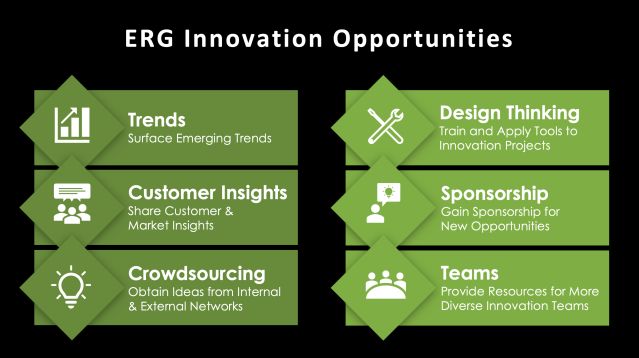Creativity
How Employee Resource Groups Drive Innovation
Unlock employees' collective strengths to drive positive organizational change.
Posted June 13, 2024 Reviewed by Lybi Ma
Key points
- Employee resource groups bring together people from diverse backgrounds around a shared goal.
- They offer businesses a way to find ideas and solve problems by including everyone in the innovation process.
- Groups innovate by identifying trends, sharing market insights, and discovering new ideas and solutions.
- Groups can be a powerful tool for businesses that want to stay competitive in a fast-changing environment.

Employee resource groups (ERGs), also known as business resources groups (BRGs) or affinity groups, are voluntary, employee-led communities that come together based on shared characteristics or life experiences, such as gender, ethnicity, sexual orientation, or even a passion for sustainability. ERGs serve as a vital resource within many organizations by providing support, enhancing career development, and contributing to personal development in the workplace.
ERGs allow members to connect, share experiences, and advocate for their interests within and outside the organization. But their impact can go far beyond fostering a sense of affiliation and belonging. ERGs are increasingly becoming a force for mobilizing people around shared goals, allowing employees to leverage their collective knowledge and perspectives to tackle challenges and drive positive change.
ERGs and Innovation
To stay competitive, organizations must adapt to market changes, meet evolving customer needs, and continuously innovate with new products, services, and processes. ERGs can play a crucial role in driving business innovation, something every organization needs to remain relevant and grow.
According to Dr. Theresa M. Welbourne with the Center for Effective Organizations at the Marshall School of Business at USC, “some well-known innovations coming out of ERGs over the years include an American multinational technology company’s ERGs creating a textured hair care essentials website for beauty and hair products for people of color, and another organization’s Hispanic/Latino ERG creating different varieties of snack foods.”
Innovation often sprouts from the ability to view challenges and opportunities through different lenses. ERGs are uniquely positioned to offer this diverse perspective. Their membership cuts across different levels and functions within the organization, enabling cross-pollination of ideas that might not occur within the usual operational silos.
For instance, ERGs comprised of younger employees or those from specific cultural backgrounds can provide insights into emerging consumer trends that senior management might overlook. These insights can be crucial for developing new products or tailoring marketing strategies to resonate with niche customer segments.
Diverse Experience: The Core Strength of ERGs
In my latest book, Experiential Intelligence, I share how experience is a crucial success factor in today’s world. Yet many of us overlook and underutilize the hidden strengths we gain from our personal and professional experiences. We often recognize the importance of IQ (Intellectual Intelligence) and EQ (Emotional Intelligence), but we lack a simple way to understand what we’ve gained from life experience.
Experience is exactly what gives ERGs the power to innovate. ERGs are uniquely positioned to support and drive business innovation because they harness the diverse mindsets, abilities, and skills of their members—who often share unique experiences while nevertheless working across departments and business units in the same organization. The wide-ranging diversity within and across ERGs can fuel creativity and help identify new opportunities that might otherwise be overlooked.
Opportunities for ERG Innovation
ERGs can spearhead innovation in a variety of ways. Here are six strategies that ERGs can use to promote and foster innovation:
- Identify emerging trends: ERGs, with their finger on the pulse of diverse communities, can help companies surface emerging trends and market shifts before competitors. Gaining insight into the trends related to shifting customer needs and social, political, cultural, and environmental change can ensure companies avoid being blindsided by trends and instead leverage them for innovation.
- Share customer and market insights: ERGs provide access to a wider range of lived experiences, helping companies understand diverse customer needs and preferences and leading to more targeted products and services. ERG members’ backgrounds and experiences can help identify unmet customer needs and market gaps that traditional data analysis might miss, leading to the creation of innovative solutions.
- Crowdsource ideas: ERGs empower employees to share ideas and develop solutions from their unique perspectives, fostering a bottom-up approach to innovation. ERGs can also be used to solicit ideas from outside the organization, drawing on the networks of ERG members to solicit and obtain ideas for new products and services.
- Apply design thinking: By incorporating diverse viewpoints at each stage of the design thinking innovation process, ERGs ensure a wider range of needs and perspectives are considered, leading to more inclusive and innovative solutions. The diversity that exists within ERGs helps spark creative brainstorming and challenge assumptions, leading to more innovative solutions to complex problems.
- Sponsor innovation: ERG members who are already in senior executive or innovation roles themselves are well-positioned to sponsor specific opportunities for new products, services, and process improvements. ERG members can also act as internal champions for ideas, ensuring that innovations are supported by the ERG as they are developed and tested.
- Build innovation teams: ERGs usually include employees with different skills and expertise, providing a vast resource pool that can be used to staff well-rounded innovation teams. Existing product development groups can also benefit from tapping into ERGs to enhance their innovation teams with ERG members.

Getting Started
To harness the power of ERGs and drive innovation within your organization, consider these steps:
- Establish and support ERGs: Encourage the formation of ERGs (or introduce innovation to existing ERGs) and provide them with funding, meeting spaces, executive sponsorship, and the imperative to innovate.
- Integrate ERGs into innovation processes: Involve ERGs in strategic planning and innovation initiatives. Ensure their insights and ideas are considered in decision-making processes.
- Provide training and development: Offer training in design thinking, problem-solving, and innovation methodologies to ERG members to enhance their ability to contribute effectively.
- Measure and communicate impact: Track the contributions of ERGs to innovation efforts and share success stories within the organization to build momentum and demonstrate the value of diversity-driven innovation.
By leveraging the strengths of employee resource groups, organizations can foster a more inclusive and innovative environment, leading to better solutions, increased competitiveness, and greater success in today’s competitive business environment.
References
ERGs at the Crossroads: The State of Employee Resource Groups Report - 2024 (April 29, 2024). Center for Effective Organizations, University of Southern California.
Kaplan, S. (2023). Experiential intelligence: Harness the power of experience for personal and business breakthroughs. (Matt Holt Books).




